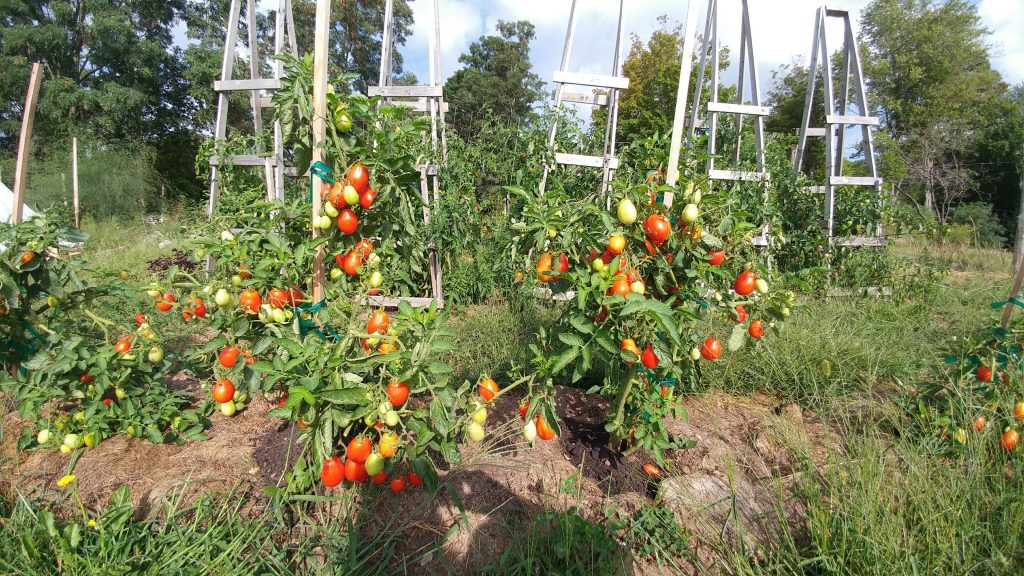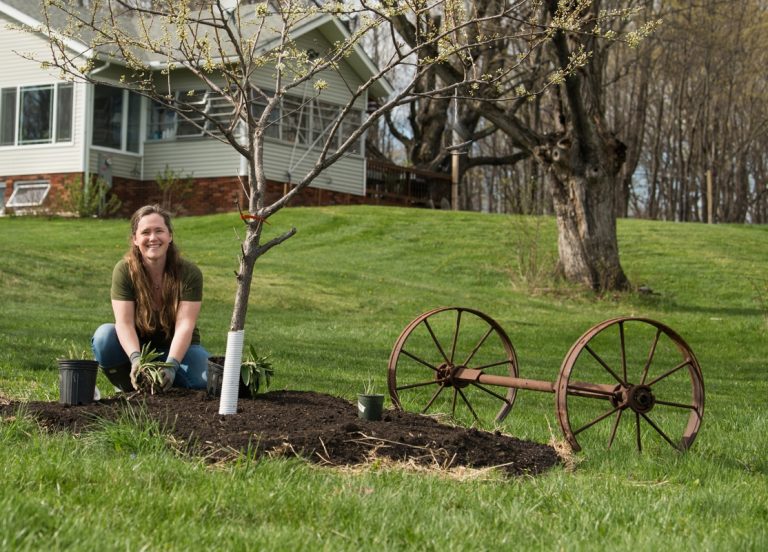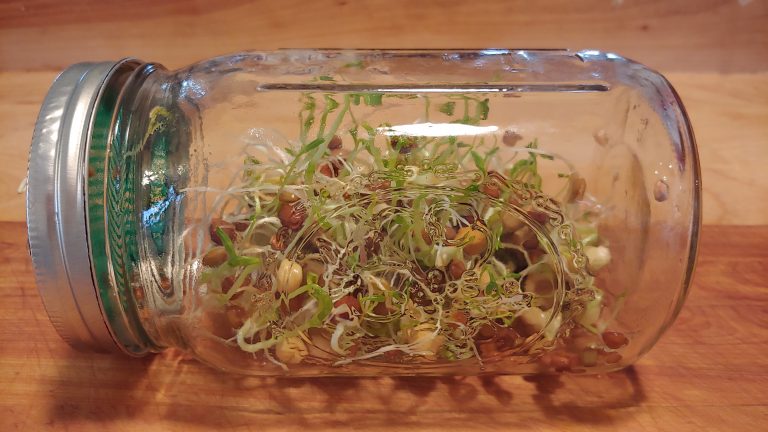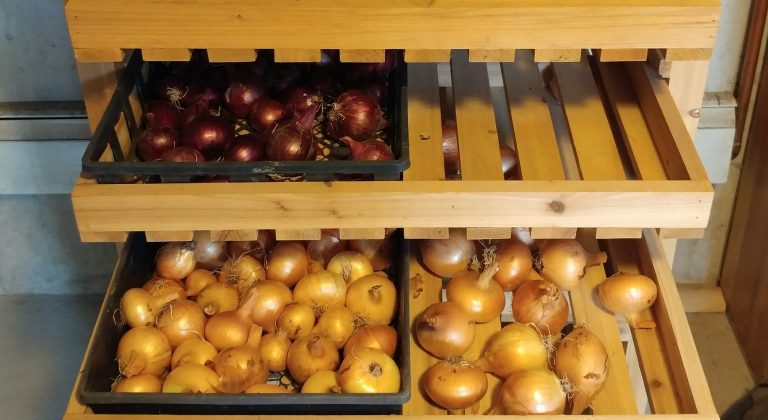This post may contain affiliate links.
Supporting garden tomatoes with tomato stakes or cages is necessary for all but a few varieties of tomatoes.
Without some form of support, your tomato plant will sprawl out over the ground. It will likely catch diseases that keep you from harvesting much of the fruit.
And it’s important to get the right kind of support. But how do you determine whether to use tomato stakes or tomato cages?
We’ve done a lot of experiments to decide which methods work, and here we’ll share some considerations to help you make a choice that will work for your garden.
The simple fact is this: deciding whether to use a cage or a stake depends on a few factors, including the type of tomato, how much pruning you want to do, and what kinds of resources you have to spend.
This article discusses each of those considerations.

What do we mean by “Tomato Cage” vs. “Tomato Stake”?
A tomato cage is a variety of support solutions that place your plant in the middle of a structure that surrounds it. It provides a variety of horizontal frames for the plant to rest on at various levels. Cages can be made of metal or wood and can be store-bought or homemade.
A tomato “stake” is one tall take made of wood or metal to which you attach your tomato plant as it grows. They are often sold in bundles and can even be homemade.
Tomato Cage Options

Cages vary greatly in their structure and strength. You can choose a circular cage. Some circular cages have horizontal circles and vertical rods that connect them. They come together toward the ground.
However, we have learned to be wary of the construction of these cages. You must prune your tomatoes for these cages to maintain their weight. They also probably won’t last more than one or two seasons.
Square metal cages are much sturdier. They will last longer. And you won’t have to prune your plant as much for success, but they will cost you more.
There are a number of other options like this, but be sure to look for “heavy duty” metal cages to get the best quality.

Homemade wooden cages are also an option. We followed this tutorial on Mother Earth News to make cages that can be folded down over the winter (on a hinge), and they have worked decently for us.
However, truth be told, the metal cages offer more resting places for your plants, so we find that they work a little bit better depending on the variety. The materials for these homemade wooden cages are affordable and fairly easy to build with just a few tools.
These cages hold up well. You could always add a few extra horizontal supports to serve your tomatoes better.
Tomato Stake Options
Tomato stakes are single posts made of wood or plastic that you place next to your plant to offer support from the center as the plant grows. They are similar to grade stakes (like you might use to mark your driveway) but taller.

You can usually find longer-length tomato stakes at a home improvement or gardening store. For example, grade stakes are often 36 inches, which might be fine depending on your variety of tomatoes, but we prefer 48-inch tomato stakes.
We find that wooden or metal stakes are stronger than plastic stakes. However, you should see what your local store offers and what works for you. When you use stakes, you’ll also need some plant ties or tape to secure your tomato stems to the stake.
So which is better for Tomatoes: Cages or Stakes?

The truth is, it depends (don’t you love that answer?). There are several things to consider including the type of tomato you are growing, how often you plan to prune the tomatoes, and the price you are willing to spend. Here we break down these questions to assist you in making a decision.
What type of tomatoes are you growing?
Determinate Tomatoes
The first question to ask about the tomatoes you’re growing is if they are determinate or indeterminate. Determinate plants are sometimes called “bush” varieties. Bush varieties grow to about 3-4 feet and are more compact.
When they reach a certain height and flower at that height, they stop growing taller and focus on producing fruit. The fruit usually ripens in a condensed period, around the same time (during a 1-2 week span).
Examples of some determinate varieties include these Italian Roma Bush Tomatoes from Botanical Interests, or these Roma Paste Tomatoes from High Mowing Seeds.
Determinate tomatoes can do well with stakes since they stop growing at a certain height. The tomatoes pictured on stakes above are a determinate variety and much shorter than our other plants.
Indeterminate tomatoes
Indeterminate tomatoes will continue to grow and produce fruit until the conditions are no longer suitable (i.e., shortened days or a frost). Depending on the variety, they can grow 6 – 12 feet high and shoot branches out at all levels.
Examples of indeterminate types of tomatoes include these beautiful Brandywine Tomatoes from Botanical Interest or these Bing Cherry Tomatoes from High Mowing Seeds.
Indeterminate varieties do better with cages because they can reach such heights, but your cage needs to be up to the challenge and offer support at least six feet tall.
Of course, you can also use a stake for an indeterminate variety if it’s tall enough, but that brings us to our next topic…
How much are you going to prune your tomatoes?
Pruning tomatoes can offer many benefits but isn’t always necessary. It all depends on how you support your tomatoes and can also be done to various degrees. Some people use a stake to keep their tomatoes to one central stem and get great results. Others don’t prune much and use a cage to compensate for our lack of time to clean things up.
If you have a sturdy cage, you can do less pruning without the risk of having your plant fall over. You can focus on pruning stems that reach down toward the ground at the bottom of the plant.
Occasionally, you must clear out above to allow air to circulate, but you can let more branches do their thing, especially with indeterminate varieties. That said, you may want to do some pruning toward the end of the season to ensure the formed fruit has time to ripen.
If you are using a stake, you’ll need to prune almost all of the bottom suckers, some of the new branches that form, and a lot of the downward facing stems that don’t have fruit. This way, you can safely tie up your plant and be sure the stake will hold its weight. If you keep up with it, you can have a very clean-looking plant with lots of fruit that produces quite well.
How much do you want to spend on Tomato Cages or Stakes?
Sometimes, the type of support you will use depends on how much you want to spend on your solution. Price and durability are related, and sometimes, the cheapest option will do for a season. However, the more expensive option will likely last much longer and save time, money, and frustration in the long run.
Wooden tomato stakes will cost you about $1-4 each, depending on if you buy in bulk, plus the cost of a roll or two of plant ties ($4). So, you can stake each tomato plant for under $5. They’ll last a few seasons, but you’ll have to keep up with the pruning to make them work, and they’re probably best suited for determinate varieties.
Homemade wooden cages like the ones pictured above will cost you about $10, plus the value of the time you spend making them. They’ll last a good five years or more and provide more sturdy support for heavier or taller tomatoes. They are a good choice for the gardener who is handy with tools and isn’t looking for the “perfect” support.
Store-bought metal cages can run anywhere from $10 – 30 each, depending on the brand and the materials. Some are even coated for a longer-lasting solution. If stored well over the winter, they can last many years.
We believe they do the best job supporting tomatoes that are freely growing tall off-shoots. Like most expensive solutions, they’re the “set it and forget it” solution. They are not always practical for the budget, but our strategy has been to buy one or two a year when they are on sale to expand our collection.
Carrie Williams Howe is an educational leader by day and an aspiring homesteader by night and weekend. She lives on a small homestead in Vermont with her husband, two children, and a rambunctious border collie. She blogs about her family's homestead life at The Happy Hive.






